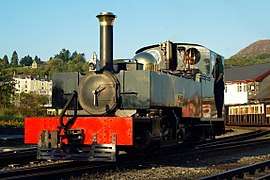Lew (locomotive)
Lew was a Manning Wardle 2-6-2T built in 1925 for the narrow gauge Lynton and Barnstaple Railway.
| Southern Railway E188 Lew | |||||||||||||||||||||||||||||||||||||
|---|---|---|---|---|---|---|---|---|---|---|---|---|---|---|---|---|---|---|---|---|---|---|---|---|---|---|---|---|---|---|---|---|---|---|---|---|---|
| |||||||||||||||||||||||||||||||||||||
| |||||||||||||||||||||||||||||||||||||
| |||||||||||||||||||||||||||||||||||||
History
Lew, following L&B tradition, was named after one of the local rivers with a three-letter name, the River Lew.
Lew was similar in design to the previous Manning Wardle locomotives built for the L&B, the main difference being a redesigned cab to eliminate a smoke trap, and give more room to the crew. She was sold at auction along with other L&B equipment in November 1935, two months after the railway closed.[1] However, she was purchased in December by a dismantler and was used to remove the line until July 1936.
On 28 September 1936,[2] Lew sailed from Swansea, on the SS Sabor – believed to have been destined for a plantation in Brazil. Sabor arrived in Pernambuco on 15 October 1936.[3] Sabor left Pernambuco on 17 October, called at Bahia on 20 October,[4] and arrived in Rio de Janeiro on 23 October.[5]
Despite the efforts of many enthusiasts, no proof of the locomotive's current whereabouts, or eventual fate has been published.
Lyd

A replica of Lew, named Lyd in accordance with the L&B tradition of naming its locos after local three-letter rivers, was completed at Boston Lodge on the Ffestiniog and Welsh Highland Railway in August 2010.[6]
References
- Bradley, D.L. (October 1975). Locomotives of the Southern Railway: Part 1. London: RCTS. p. 85. ISBN 0-901115-30-4.CS1 maint: ref=harv (link)
- "Toy Railway Engine". Western Morning News. England. 29 September 1936. Retrieved 15 August 2017 – via British Newspaper Archive.
- "Mail and Steamship". Aberdeen Press and Journal. Scotland. 17 October 1936. Retrieved 15 August 2017 – via British Newspaper Archive.
- "Mail and Steamship". Aberdeen Press and Journal. Scotland. 22 October 1936. Retrieved 15 August 2017 – via British Newspaper Archive.
- "The Mails". The Scotsman. Scotland. 27 October 1936. Retrieved 15 August 2017 – via British Newspaper Archive.
- "New replica steam locomotive unveiled in Ffestiniog". BBC News. 9 August 2010. Retrieved 9 August 2010.